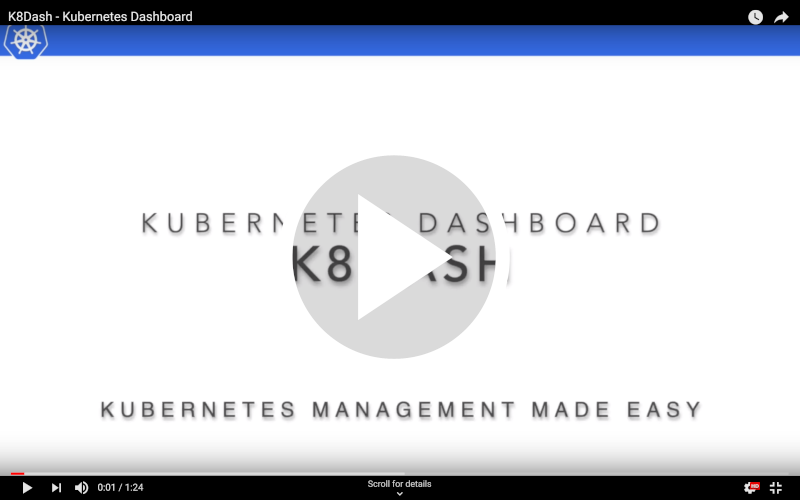K8Dash is the easiest way to manage your Kubernetes cluster. Why?
- Full cluster management: Namespaces, Nodes, Pods, Replica Sets, Deployments, Storage, RBAC and more
- Blazing fast and Always Live: no need to refresh pages to see the latest
- Quickly visualize cluster health at a glance: Real time charts help quickly track down poorly performing resources
- Easy CRUD and scaling: plus inline API docs to easily understand what each field does
- Simple OpenID integration: no special proxies required
- Simple installation: use the provided yaml resources to have K8Dash up and running in under 1 minute (no, seriously)
- A running Kubernetes cluster
- metrics server installed (optional, but strongly recommended)
- A Kubernetes cluster configured for OpenId Connect authentication (optional)
Deploy k8dash with something like the following...
NOTE: never trust a file downloaded from the internet. Make sure to review the contents of kubernetes-k8dash.yaml before running the script below.
kubectl apply -f https://raw.githubusercontent.com/herbrandson/k8dash/master/kubernetes-k8dash.yamlTo access k8dash, you must make it publicly visible. If you have an ingress server setup, you can accomplish by adding a route like the following
kind: Ingress
apiVersion: extensions/v1beta1
metadata:
name: k8dash
namespace: kube-system
spec:
rules:
-
host: k8dash.example.com
http:
paths:
-
path: /
backend:
serviceName: k8dash
servicePort: 80There are multiple options logging into the dashboard.
The first (and easiest) option is to create a dedicated service account. The can be accomplished using the following script.
# Create the service account in the current namespace (we assume default)
kubectl create serviceaccount k8dash-sa
# Give that service account root on the cluster
kubectl create clusterrolebinding k8dash-sa --clusterrole=cluster-admin --serviceaccount=default:k8dash-sa
# Find the secret that was created to hold the token for the SA
kubectl get secrets
# Show the contents of the secret to extract the token
kubectl describe secret k8dash-sa-token-xxxxx
Retrieve the token value from the secret and enter it into the login screen to access the dashboard.
K8dash makes using OpenId Connect for authentication easy. Assuming your cluster is configured to use OIDC, all you need to do is create a secret containing your credentials and run the kubernetes-k8dash-oidc.yaml config.
To learn more about configuring a cluster for OIDC, check out these great links
- https://kubernetes.io/docs/reference/access-authn-authz/authentication/
- https://medium.com/@mrbobbytables/kubernetes-day-2-operations-authn-authz-with-oidc-and-a-little-help-from-keycloak-de4ea1bdbbe
- https://medium.com/@int128/kubectl-with-openid-connect-43120b451672
- https://www.google.com/search?q=kubernetes+configure+oidc&oq=kubernetes+configure+oidc&aqs=chrome..69i57j0.4772j0j7&sourceid=chrome&ie=UTF-8
You can deploy k8dash with oidc support using something like the following script...
NOTE: never trust a file downloaded from the internet. Make sure to review the contents of kubernetes-k8dash-oidc.yaml before running the script below.
OIDC_URL=<put your endpoint url here... something like https://accounts.google.com>
OIDC_ID=<put your id here... something like blah-blah-blah.apps.googleusercontent.com>
OIDC_SECRET=<put your oidc secret here>
kubectl create secret -n kube-system generic k8dash \
--from-literal=url="$OIDC_URL" \
--from-literal=id="$OIDC_ID" \
--from-literal=secret="$OIDC_SECRET"
kubectl apply -f https://raw.githubusercontent.com/herbrandson/k8dash/master/kubernetes-k8dash-oidc.yaml
K8dash relies heavily on metrics-server to display real time cluster metrics. It is strongly recommended to have metrics-server installed to get the best experiance from k8dash.
K8dash is made up of 2 parts. The server and the client.
To run the server, run npm i from the /server directory to install dependencies and then npm start to run the server.
The server is a simple express.js server that is primarily responsible for proxying requests to the Kubernetes api server.
During development, the server will use whatever is configured in ~/.kube/config to connect the desired cluster.
For the client, move to the /client directory, run npm i and then npm start. The client is a React application with minimal other dependencies.

